Once you arrive in Thailand, there are many transportation options to choose from to get around the country. Whether you want to explore the bustling city streets or take a journey to a rural village, there are many ways to get there. In this post, we’ll be looking at the various forms of local transportation in Thailand and giving you some tips on how to get around. So, buckle up and let’s embark on an adventure through Thai transportation!
Tuk Tuks
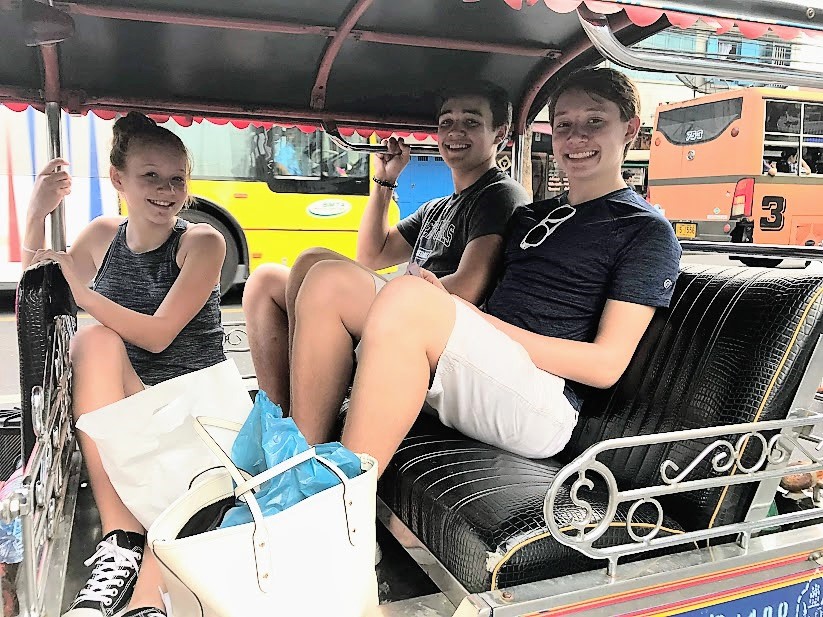
One of the most popular and iconic modes of transportation in Thailand is the Tuk Tuk. These three-wheeled motorized rickshaws can be found buzzing through the streets of Bangkok and other major cities, offering a fun way to get around.
To catch a tuk tuk, simply flag one down on the street or ask your hotel concierge for help. Be sure to agree on the fare with the driver before setting off. Prices can vary widely depending on the distance and time of day. It’s ok to haggle with the driver if you feel the rate is too high. Consider however the favorable exchange rate and decide whether negotiating to save a few cents is worth your time and trouble.

Also be aware that many Tuk Tuk drivers will sometimes offer you a free tour of a local attraction. They often do this because they get a commission from local businesses for bringing tourists there in hopes that you will spend some money. It’s important to stay firm and be clear about your destination with the driver.
While not always the most luxurious transportation option, Tuk Tuks are known for their speed and maneuverability. This makes them a popular choice for short trips around town. Just be sure to hold on tight! Drivers want to get you to your destination quickly so they can pick up their next fair.
Water Taxis

Another unique mode of transportation in Thailand is the water taxi or “long-tail boats.” Bangkok, in particular, is famous for its waterways, and taking a water taxi can be a fun way to explore the city. It’s an excellent way to escape the traffic on the roads and experience a different perspective of the city from the water. These boats can travel at high speeds, making them a quick and efficient way to get around; often faster than taking a car or Tuk Tuk (Rickshaw) on the busy roads.
It’s important to negotiate a fair price with the driver before boarding the boat. Some drivers may try to overcharge tourists, so it’s essential to know the going rate for the journey you’re taking. Just be aware that it can be a bumpy ride, especially if the water is choppy. Be sure to hold onto something sturdy!
For those looking for a more luxurious experience, there are private water taxis available for hire. These boats offer a more comfortable and personalized experience, allowing you to explore the city at your own pace. Some even come equipped with a guide who can offer insights into the city’s history and culture.
Chao Phraya Express Boat
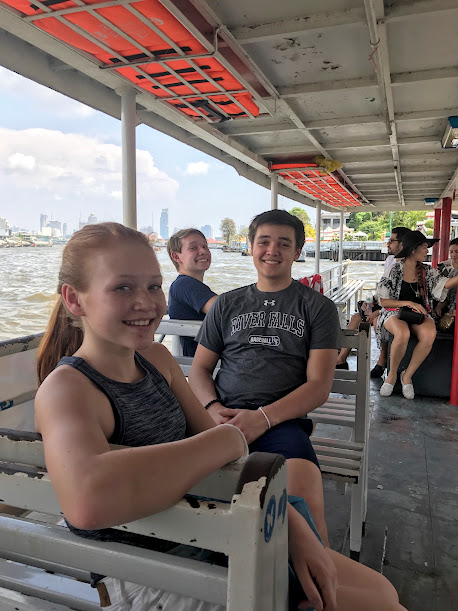
The Chao Phraya Express Boat provides river transportation services on the Chao Phraya River, Bangkok, Thailand. It is like a river bus providing express river transportation in Bangkok and the surrounding areas
The Chao Phraya Express Boat Company serves both local commuters and tourists. The 21 km (13 mi) route is served by 65 boats and carry an average of about 40,000 passengers per day.
Check the website chaophrayaexpressboat.com for the latest schedule.
Grab Cars

In recent years, Grab Cars (the Southeast Asian version of Uber or Lyft) have become increasingly popular in Thailand, especially in the larger cities like Bangkok and Chiang Mai. Grabs offer a safe and convenient way to get around, and the prices are usually reasonable.
One of the best things about using a Grab is that you can set your destination and know the price upfront, so there are no surprises or haggling required. This is particularly useful if you don’t speak Thai. Additionally, Grabs are readily available throughout the day and night, so you can get to your destination quickly and easily.
To use a Grab, all you need to do is download the app, create an account, and add your payment information. From there, you can set your pickup and drop-off locations, choose your vehicle type (such as a car or motorbike), and request your ride. Your driver will usually arrive within a few minutes, and you can track their location in real-time through the app.
Grabs are a great option for longer journeys, or if you’re traveling with a group and need more space. However, they may not be the best option for shorter distances, as the base fare can be quite high. In these cases, it might be more cost-effective to take a Tuk Tuk.
Check out my blog post on Grab cars for more information findingthailand.com/how-to-use-grab-cars-in-thailand/
Private Drivers

If you’re looking for a more personalized mode of transportation in Thailand, hiring a private driver is an excellent option. Private drivers offer flexibility and comfort, allowing you to plan your itinerary and travel in style.
You can easily book a private driver through your hotel or via various transportation apps. Many private drivers also offer day trips and excursions to popular tourist destinations. Prices for private drivers vary depending on the distance traveled, the driver’s expertise and the vehicle.
One of the best things about hiring a private driver is the ability to create your own itinerary and explore lesser-known destinations at your own pace. Your driver can offer insider knowledge and take you to hidden gems that most tourists miss.
We booked our driver through Daytrip.com to get from Chiange Rai to Chiange Mai. Our driver Mr. Nai stopped at attractions along the way making the journey very enjoyable. After the half day trip, we called him directly and he became our private driver for the duration of our stay. He brought us to temples and markets we would have never known about without someone local guiding us. He even picked us up to bring us to the airport on our last day and insisted no charge. Surprising to us, he had stopped on the way to get us to pick up our laundry that we had dropped off the day before. You can’t beat that type of hospitality and service and the cost was very reasonable.
Taxis
Taxis are available in every major city in Thailand and are often the most convenient way to travel for short to medium distances. However, they can be a bit more expensive than other options, especially during peak hours and in tourist areas. Only use licensed taxis with the taxi meter in working condition to avoid scams. If a driver refuses to use the meter, it is better to find another taxi.
For longer distances, you can negotiate a price with the taxi driver for a flat rate. Some taxi drivers can also serve as a tour guide and show you around the city for a set fee.
You will know if an incoming taxi is available when you see a glowing red sign in the front window. This sign is the Thai script for the word ‘free.’
Don’t take the first taxi you see parked outside your hotel, pub, bar or tourist attraction. Oftentimes, these drivers will refuse to use the meter or want to take you to places you don’t want to go. It is far better to walk out on the street and hail a moving taxi.
Local Trains
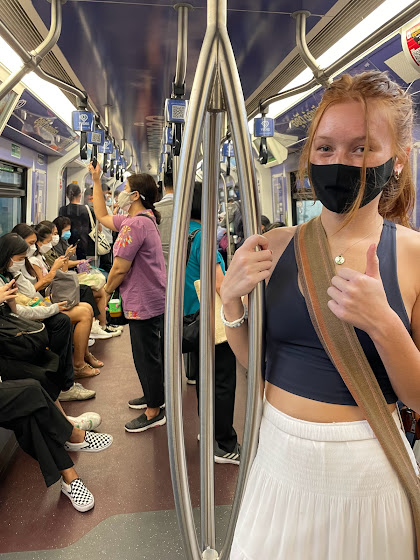
Bangkok has an extensive network of local trains, including both elevated and underground lines. Both the BTS and MRT are fast, efficient, and affordable means of getting around Bangkok. They operate from 6 am to midnight daily, with trains arriving every few minutes during peak hours. Fares are based on distance traveled, with a minimum fare of 15 baht for the BTS and 16 baht for the MRT. Both systems accept a contactless smart card called the Rabbit card, which can be topped up at any station.
The elevated trains are operated by the BTS (Bangkok Mass Transit System) and cover two main routes: the Sukhumvit Line and the Silom Line. The Sukhumvit Line runs from Mo Chit in the north to Bearing in the south, with a total of 23 stations. The Silom Line runs from Thonburi in the west to Bang Wa in the south, with a total of 13 stations. Both lines intersect at Siam Station in the city center.
The underground trains are operated by the MRT (Mass Rapid Transit) and cover a single route: the Blue Line. The Blue Line runs from Bang Sue in the north to Hua Lamphong in the south, with a total of 18 stations. The Blue Line intersects with the BTS at two stations: Silom and Sukhumvit.
Cross-Country Trains
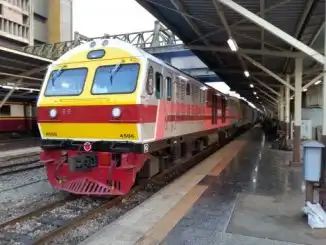
While Thailand may not have the most advanced railway system in the world, taking the train is still a popular and budget-friendly way to get around the country. Trains in Thailand generally offer a comfortable ride, with both first and second-class options available.
One of the most popular train routes in Thailand is the Bangkok-Chiang Mai line, which takes you through the heart of the country’s scenic northern region. Along the way, you’ll pass through lush forests, winding rivers, and mountainous terrain, making for some truly unforgettable views. This can also be taken as a night train, saving a night of hotel fairs.
Another popular route is the Bangkok-Surat Thani line, which is a great option for those heading to Thailand’s southern islands like Koh Samui or Phuket. From Surat Thani, you can then take a bus or ferry to your final destination.
While train travel in Thailand may not be as fast or convenient as other options like flying or taking a private driver, it’s a great way to see the country up close and experience the local culture. Plus, with prices as low as a few dollars for a second-class ticket, it’s hard to beat the value for money.
Domestic Flights

For longer journeys across Thailand, domestic flights are a popular option. With several domestic airlines operating within the country, including Thai Airways, Bangkok Airways, and Nok Air, there are many options for getting around.
Flights can be booked online, or through travel agents in larger cities. It’s important to note that some flights may only operate on certain days of the week, so it’s best to plan ahead.
Although flying may cost more than alternative modes of transportation in Thailand, it is a practical means of saving time and exploring more of the country. Moreover, several flights provide breathtaking vistas of Thailand’s terrain, ranging from verdant woodlands to immaculate coastlines.
If you’re planning on flying within Thailand, make sure to arrive at the airport with plenty of time before your flight. While the security process is relatively quick, lines can form at busy times. It’s also a good idea to pack light, as domestic airlines often have stricter luggage restrictions than international flights.

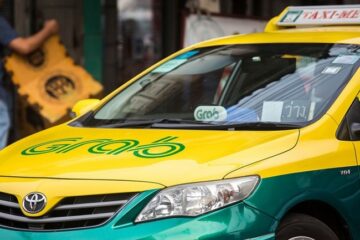
0 Comments